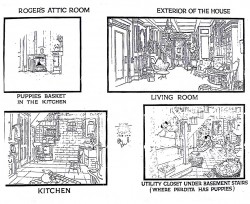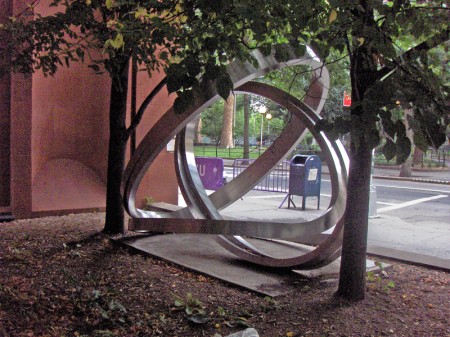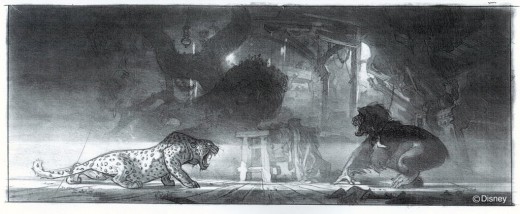Category ArchiveCommentary
Commentary 06 Sep 2008 07:42 am
Bill Melendez
 - I never got to meet Bill Melendez. However, I did speak with him. In 1976 I was writing an article for Millimeter Magazine. My task was to discuss the commercial scene in animation studios. Among those I contacted was the Melendez studio, and in the first call I got through to Bill Melendez, and we spoke on the phone for more than half an hour.
- I never got to meet Bill Melendez. However, I did speak with him. In 1976 I was writing an article for Millimeter Magazine. My task was to discuss the commercial scene in animation studios. Among those I contacted was the Melendez studio, and in the first call I got through to Bill Melendez, and we spoke on the phone for more than half an hour.
There was no doubt that I liked this guy. He was affable and friendly and giving. He made my job easy; he answered every one of my questions in depth. Of course, given the opportunity, I had to ask a number of questions that interested me personally about producing the many shows he was making, about his history at UPA, about a number of other impertinent items. I got no sense from Bill that he took this as off-topic, and I tried not to overstep my bounds too far. He invited me to meet with him the next time I was in LA (which I stupidly never did), and couldn’t have been more gracious.
I’m truly sad I didn’t meet him, and now it’s too late. I’m curious to see what will become of his studio; I hope the work continues there.
Bill Melendez obituaries are out there, and they’re not all identical.
Here’s:
Charles Solomon for the LA Times
the NYTimes
the Washington Post
Variety
AWN
Cartoon Brew still stands high.
The ASIFA Hollywood Animation Archive has an interesting interview between Bill Melendez and Tom Sito.
Here’s an interview on YouTube.
Commentary 04 Sep 2008 07:50 am
Melendez, Engel and Palin
Bill Melendez
- I was truly saddened to learn of Bill Melendez’ death via Cartoon Brew. I’ll have to collect my thoughts on this one, having just heard the news, and write a later piece.
Tom Sito also wrote a nice piece on his site worth reading.
Jules Engel
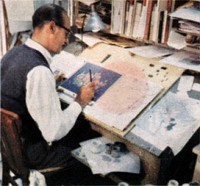 – There’s a new (to me) site set up for the appreciation of Jules Engel‘s work. There you can find a film by Janeann Dill Elegy for Jules which is just that, an abstract elegy. The site also includes a guestbook for others to leave memories or comments about Jules.
– There’s a new (to me) site set up for the appreciation of Jules Engel‘s work. There you can find a film by Janeann Dill Elegy for Jules which is just that, an abstract elegy. The site also includes a guestbook for others to leave memories or comments about Jules.
There is also a Facebook page for Jules Engel that’s worth viewing. On Saturday, September 13th, the fifth anniversary of Jules’ death, they are celebrating with a host of stories and writings about Jules on the Facebook page. “Everyone is invited to participate. Add a new discussion thread, or post drawings or animations or photos or video tales to share with those who knew him and with those who did not.”
- Here’s Janeann Dill‘s interview with Engel.
- Cartoon Modern displays some color designs Engel did for Magoo’s 1001 Arabian Nights, the Alvin Show, Gerald McBoing Boing and others. Worth the visit. The photo of Engel, to the right, is from Cartoon Modern.
- Asifa Hollywood’s Animation Archive posts some color keys for the Alvin Show by Engel.
- This is the Artsconversation page for Jules Engel including QT interviews and some of his artwork.
- For more information, here is a biographical page including chronology on Sullivangoss.com.
__________________________________________________________________
Raw Meat

- It’s quite hard not commenting on the ridiculous firestorm that’s arisen over this Vice Presidential pick of John McCain. The past few days have been filled with sexist photos, wacky stories and endless ravings of the psychotic fringe end of the Republican parties. Honorable good ol’ gals like Christie Todd Whitman and Olympia Stowe were pushed out of the way for the sexy, anti-abortion, hunter of the Alaskan north and comments about her. The stories have filled the airwaves and the emails to the point of exhaustion.
Watching her read the speech written for her by Matthew Scully (who also wrote Dan Quayle’s acceptance speech) was disconcerting. She hit an in-the-park homerun for the meat-eaters at the convention. The first ten minutes of the speech introduced her family; the next fifteen were given to attacking Obama. Since the bar was set so low for her, the fact that she could read was enough to get her to third base. The speech used humor, and Sarah Palin delivered the barbs well. Of course, no mention was made of what she or her running mate would do for the populace.
An interesting side note to the speech. According to the NYTimes, Matthew Scully, the speech writer, wrote the text on the teleprompter helpfully spelling the word “nuclear†phonetically — as “new-clear.â€
I’m waiting to see her on the stump when there are no speech writers around and no John McCain stealing the screen as he wobbles behind her, impatiently waiting for her to finish so he can pander down to her.
By the way, what’s with this Republican Party? Are they all white, fat and over 60? That’s how it looks on tv. Tonight the “BIG” speech is scheduled, but we’ve all seen McCain give speeches in his angry intemperate way. I expect more of the same, but we’ll see. Hopefully, he’ll have some help.
Commentary 31 Aug 2008 08:28 am
Richie Havens
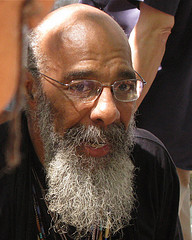 – The recent post about Richie Havens by Annulla (who photographed the picture to the left) on her blog, Blather from Brooklyn, brought back a short memory I have from a number of years ago. I think it was 1984.
– The recent post about Richie Havens by Annulla (who photographed the picture to the left) on her blog, Blather from Brooklyn, brought back a short memory I have from a number of years ago. I think it was 1984.
I’d received a call out of the blue from Mr. Havens. Now, remember I grew up in the Sixties and was a part of the “Woodstock Generation.” I loved the music of the period and Havens was a big part of that – especially to a New Yorker. This call was a shock. I was asked to come meet with him about an animation project he was assembling. No questions asked, I got the date and time and showed up.
It was in the very theatrical (albeit seedy at the time) area of 8th Avenue and 56th Street. I arrived to a very large open space. A very wide open, not-overly-furnished space. After a brief greeting, I was directed to the only other seat in the room – easily ten or more feet away in the somewhat dark room. Richie Havens, dressed in dashiki, was graced with some light that offered a halo around his head, and I sat out of the spotlight.
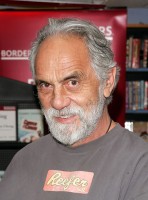 Apparently, Tommy Chong had decided to make an animated feature. He wanted to film a Kung fu style film in live action and rotoscope this into an animated film. Richie Havens was acting as his representative and was interviewing me for the position of assisting Mr. Chong in any way possible to get this film made. They saw this as a complete breakthrough feature for animation. Nothing had been done like it before.
Apparently, Tommy Chong had decided to make an animated feature. He wanted to film a Kung fu style film in live action and rotoscope this into an animated film. Richie Havens was acting as his representative and was interviewing me for the position of assisting Mr. Chong in any way possible to get this film made. They saw this as a complete breakthrough feature for animation. Nothing had been done like it before.
My alarms went off, and I decided I shouldn’t be too enthusiastic about the project. I didn’t want to turn them down on the spot, but I didn’t want to be involved. Rotoscoping and Kung fu movies were not my – - – interest.
It was a not very long meeting; there weren’t many specifics Mr. Havens could offer at the time. It was the earliest of stages. I left my samples, shook his hand again and still remember the meeting twenty years later. I think it was another of those films that never got made.
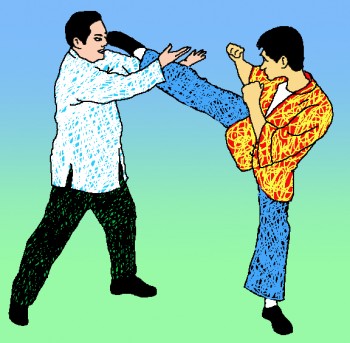
Perhaps the film would have looked like this.
Commentary 30 Aug 2008 07:44 am
realtime
Congratulations to Peggy Stern and John Canemaker. Their film, Chuck Jones: Memories of Childhood, will participate in the Telluride Film Festival. The half hour short film, which combines an interview with the legendary animator including newly created animated segments, will be shown on Turner Classic Movie in March 2009. (Perhaps it’ll be nominated for the Oscar as Best Doc short, and I’ll see it projected in January.)
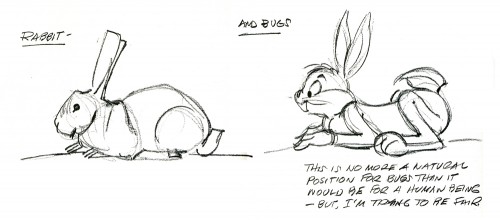
John will also participate in the Ottawa Animation Festival at the end of Sept. He’ll interview Richard Williams on stage and will then bring that show to NY’s Museum of Modern Art.
- The world of animation took a back seat for me this past week. This week was about the Presidency. The Democratic convention started off a bit slow and felt a bit off-kilter to me, but started building once Hillary spoke. When Bill Clinton and Joe Biden spoke, I was over the top. Even so, I was not prepared for the bigness of Thursday’s events. I felt like one of Reverend Moon’s groupies, ready to follow anywhere.
Obama is someone who can speak articulately and intelligently, someone who knows how to pronounce the word “nuclear” and isn’t afraid to roll off daring plans to promote the necessary kindness we owe each other, and he’s built his entire platform around that.
How unlike the current admiinistration is this. They exploit the disadvantaged to their own gains. Everything about their work has been to fatten their own pockets – both the real and the intangible. Why did we have to spend the last years listening to stories of people being tortured by this administration? Why did we have to learn of the invasive attacks on our rights – most noticeably the right of privacy? Why does anyone have to consider whether this is OK or not?
And then the week ends with John “sell-your-soul” McCain selecting an unquestionably unqualified person to be his vice presidential choice. She has governed so few in her past and is now, potentially, the selection to control America’s place in the world. What was he thinking? How irresponsible. He’d only met her once and spoken with her twice prior to selecting her. The Evangelical Christians are happy, but McCain has proven himself to be an insubstantial fool to the rest of thinking America. The Press calls that daring. After, 8 years of embarrassment with GWBush in office, can you imagine that it could possibly get worse!?!
Yes.
“The times are too serious the stakes are too high for the same partisan playbook.” Yet, this is all McCain et al can offer. Obama acts like a politician, too. But he seems to be concerned about the common good. There’s no doubt about McCain’s motives. It’s pathetic.
Thank god, Bill Maher returned to HBO as of last night. I needed to laugh off Friday’s Republican positive-mood killer.
Commentary 18 Aug 2008 07:44 am
Burstin’ Out
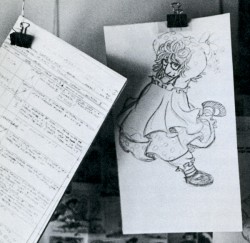 - This past week, Paul Spector offered some drawings of and by his father, Irv Spector, that were done while in the Signal Corps during WWII. The cartoons and caricatures were all drawn by artists from the varied studios working for the Army as cartoonists. Usually, these pictures don’t make a lot of sense to those outside of the studio and the immediate situations being caricatured. However, in posting this group of drawings en masse, I was taken by the high calibre of the art styling of the images.
- This past week, Paul Spector offered some drawings of and by his father, Irv Spector, that were done while in the Signal Corps during WWII. The cartoons and caricatures were all drawn by artists from the varied studios working for the Army as cartoonists. Usually, these pictures don’t make a lot of sense to those outside of the studio and the immediate situations being caricatured. However, in posting this group of drawings en masse, I was taken by the high calibre of the art styling of the images.
In the numerous studios I’ve worked cartoons were usually drawn. The larger the studio, the
____Tissa David’s self caricature in________greater the number of cartoons. I have at least
________the Canemaker book.___________100 of these cartoons saved from the Raggedy Ann experience where I became the lead character in an almost-daily strip drawn by assistant animator, Jim Logan. Lots of the other artists chimed in with many, many cartoons. (You can see a couple of these – certainly not the best which were very vicious – in John 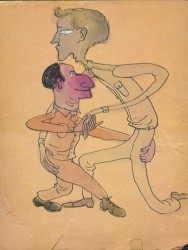 Canemaker‘s book, The Making of Raggedy Ann. Unfortunately, my folder of these cartoons is in storage or I’d post some of them.)
Canemaker‘s book, The Making of Raggedy Ann. Unfortunately, my folder of these cartoons is in storage or I’d post some of them.)
The thing about all these pictures is that they’re not, of course, art. They’re meant as quick funny gags trying to get a laugh. Some of those many Raggedy Ann drawings have style – Jim Logan’s quick sketches were the most vibrant and memorable – but most of them are just funny and without any visual gravity.
I think of this because I noted that in all of the cartoons I’ve seen from the Spector collection, there’s a real sense of art – modern art. These guys in the Signal Corps were obviously aware of Steinberg, Picasso, Matisse and the moderns.
This is a few years before UPA existed, although it’s likely that discussions of modern art moving into animation had been discussed by these guys. However, you can see in their cartoons that the 20th Century Art had become part of the fabric of 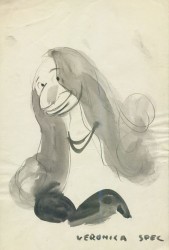 their very drawing styles. It was certainly bubbling to the top and waiting to burst out of them. UPA and the change was inevitable and couldn’t have been stopped, once someone would finance them.
their very drawing styles. It was certainly bubbling to the top and waiting to burst out of them. UPA and the change was inevitable and couldn’t have been stopped, once someone would finance them.
In discussing this with Paul Spector, he responded con-tinuing the subject. I thought this sentence of his particularly pertinent to the subject:
___I can only say that you could have found my dad at
___MOMA just as often as at the Met, and since he didn’t
___live in a vacuum no doubt he was not the only cartoonist
___doing this.
Thge point was that a large group of the cartoonists were keeping up with the arts. They were going to modern museums looking at 20th Century Art. Cartoonists such as Jack Kinney, Fred Moore and Norm Ferguson drew what came natureally. Others like VIP, John Hubley, and Sam Cobean studied new art and absorbed it into their system. This is what they drew naturally.
Of course, once UPA was successful others quickly jumped in and expressed themselves in an art style they truly appreciated. Tex Avery‘s style changed drastically from the cartoon naturalism to flat, angled art. He took the new style from MGM to Walter Lantz. Ward Kimball took the opportunity of a low profile music short to introduce his version of UPA with Toot Whistle Plunk & Boom and won the Oscar for it. Even Paramount tried their hand by thickening the outer linework and keeping a thinner inner line. They also flattened everything. It was art, but it was bold for them. Terrytoons, prior to the big change under Gene Deitch, had only the natural kraziness of Jim Tyer, who could only have existed as wildly as he became under a UPA era.
They were drawing this material in their cartoon sketches; it had to come out in their animation.
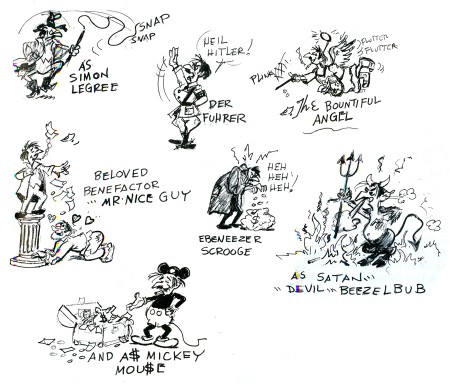
Jack Kinney’s caricature of the “7 faces” of Walt.
from Kinney’s Walt Disney and Assorted Other Characters.
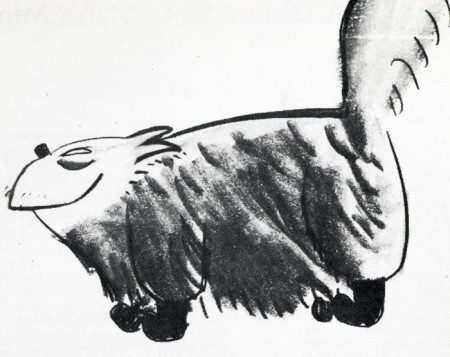
Dick Huemer as drawn by Joe Grant
from Mike Barrier’s Funnyworld #17
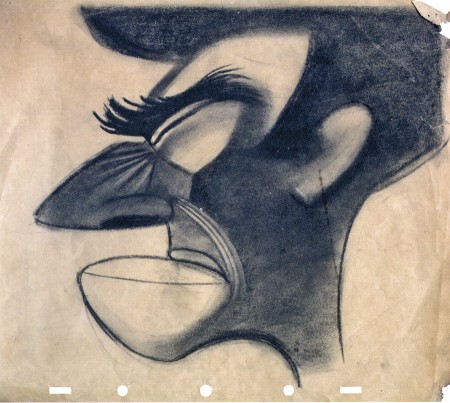
John Hubley’s caricature of Bob McIntosh
from Amid Amidi’s Cartoon Modern

Fellini’s caricature of composer, Nino Rota.
Not all artists are animators.
Animation Artifacts &Comic Art &Commentary 16 Aug 2008 07:58 am
Odds and More Ends
Today’s NY Times features a Blog/Article that analyzes all of the Star Wars movies. The author, Chris Suellentrop, says the new video game is “small consolation for the realization that the franchise that dominated their lives for 30 years has ceased to matter.”
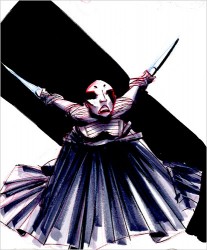 Lucas’ Cloned Wars received one star
Lucas’ Cloned Wars received one star ![]() from all of the NY papers, including the NY Daily News. JOE NEUMAIER says of the film, it’s “chock-full of video game-style action scenes and drawn to resemble the puppets in the 1960s British TV show “Thunderbirds,” is just as wooden as the last few live-action movies…”
from all of the NY papers, including the NY Daily News. JOE NEUMAIER says of the film, it’s “chock-full of video game-style action scenes and drawn to resemble the puppets in the 1960s British TV show “Thunderbirds,” is just as wooden as the last few live-action movies…”
NATHAN LEE in the NY Times says: “it isn’t the most painful movie of the year!”
The NY Times also has a slide show feature of “concept art” from the film (five images.) That’s where I pulled the image to the left.
Newsday‘s RAFER GUZMÃN (AP) says: “the film feels like an unauthorized knock-off, one of those “tribute” shorts that pop up on fan Web sites.”
Apparently this is the pilot for a new series coming to Cartoon Network. It’s obviously part of their push to get more 14 year old boys to watch. I guess it’s a positive that it’s not a live action series for CN. I wonder how long it will be before Lukas clones “Indiana Jones”?
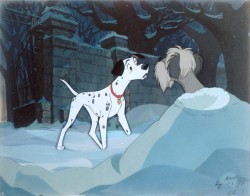 – Mark Mayerson, as you probably know, still continues to post his wonderful Mosaics on 101 Dalmatians and gives the excellent commentary with it. I write this only to remind you to keep up. Mark’s work is an enormous resource that can be too easily taken for granted. I wish he were able to print these up in book form. Perhaps, some day Disney books will realize there’s an excellent publication for grab here. “?
– Mark Mayerson, as you probably know, still continues to post his wonderful Mosaics on 101 Dalmatians and gives the excellent commentary with it. I write this only to remind you to keep up. Mark’s work is an enormous resource that can be too easily taken for granted. I wish he were able to print these up in book form. Perhaps, some day Disney books will realize there’s an excellent publication for grab here. “?
- Robert Cowan‘s art collection includes a cel set-up (above left) that seems to jump right off Mark’s mosaic. How interesting that Mark chose that particular set-up. How great the Cowan collection is; take a look at the site if you’re not familiar with it or if you haven’t been there in a while. You should also look at his Comic Art collection. There, you’ll find everything from Burne Hogarth to George MacManus to Winsor McCay.
- On the Animation Archive site, I found these Bg. plans for 101 Dalmatians. It really defines the layout of the house. In case you don’t know this site, they have dozens of model sheets for viewing. Some are brilliant, some are bad copies, all are worth checking out.
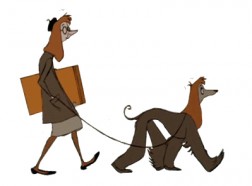
- I received an interesting art link yesterday which displays accredited art colleges to create a comprehensive directory for potential students to browse. Since I’m sure a lot of students check out this blog, I thought it might be a useful link for some readers out there. It’s called FindYourArtSchool.com.
For those considering an education in fields relevant to animation, this may be helpful.
.
Commentary 11 Aug 2008 08:27 am
From soup to nuts
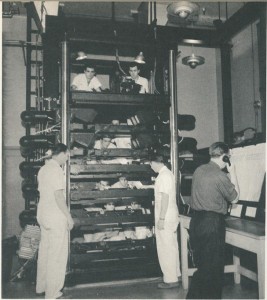 - To me, the most valuable posts of the last week or so came from Hans Perk on his blog, A Film LA. There he displayed some amazing artifacts showing patent papers and many photographs of Disney’s Vertical Multiplane Camera stand.
- To me, the most valuable posts of the last week or so came from Hans Perk on his blog, A Film LA. There he displayed some amazing artifacts showing patent papers and many photographs of Disney’s Vertical Multiplane Camera stand.
Ever since first seeing the drawings and photographs of the multiplane camera in Bob Thomas’ 1958 edition of The Art of Animation. I searched all the Disney films after that looking for where the camera was used. I scouted for information about the camera. Once I started filming my artwork (in 8mm) my brother-in-law and father teamed to construct one for me. It employed 12 levels of glass and about 6000 watts of light. Each level was about 24″ x 36″. I used this for many many film bits done between ages 14 and 17. (I still have it in storage, though I assume all the glass is broken and the lights are gone.)
In the last week, there has been more hard information here on the subject than I think I’ve seen in my lifetime, and believe me I’ve looked. I can only thank Hans for taking the time to offer this selection of material. If you haven’t seen the seven part series, go.
- Taking a 180° turn, I found this article in the Hollywood Reporter over the weekend. It is about new developments in Performance Capture. You can’t access the article without a subscription to the magazine, so I’ve reprinted the first few paragraphs.
- Man-to-man discussion
Creating CG actors on agenda at Siggraph
By Carolyn Giardina
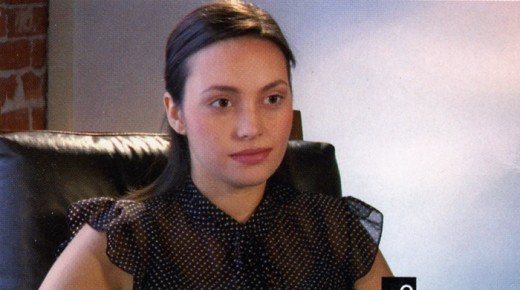
A computer-generated face has replaced the real face on this live-action body.
LOS ANGELES – Advancements in creating photoreal CG “human” characters and the related subject of motion capture will be key topics at Siggraph 2008, the international conference and exhibition on computer graphics and interactive techniques that opens Monday at the Los Angeles Convention Center.
“We are now at a point where we can create photoreal characters, but it is hugely labor-intensive and it is really expensive ” said Oscar-winning VFX supervisor Michael Fink (“The Golden Compass”), who recently was named president of VFX worldwide at Frantic Films VFX and Prime Focus Group.
“Can we do an absolutely, totally realistic Elvis Presley? Probably not. But that is because he is so well known,” he said. “But if we had to create a character that nobody had ever seen before ? That might be possible at this point. And in a few years it will be possible to do EMs. Alot of people think it is possible now. I don’t.”
Motion capture, also called performance capture, is the process of digitally recording an actor’s movement. It is not new, but the technology involved is advancing, making the process faster, more accurate and more flexible for VFX/animation houses to incorporate into their CG character creation.
This summer, Industrial Light + Magic used the technique to capture Robert Downey Jr.’s performance for their CG Iron Man. And Digital Domain similarly captured performances for its CG terra cotta army and foundation army in “The Mummy: Tomb of the Dragon Emperor.”
“It went from a reference tool to a body-animation tool. Now we are getting to facial motion capture — and all with less and less constricting systems,” Digital Domain CEO Mark Miller said.
As I’ve stated in the past, I’m not sure how long 2D animation will exist, but things are certainly changing quickly. Pixar keeps getting more and more realistic in their approach; obviously they know something.
And yes I am being provocative – for a reason.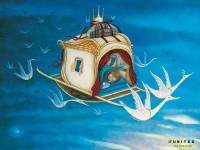
– The beautiful new ads for United Airlines are worth viewing. They’re quite stunning. Thanks to Amid on Cartoon Brew for directing me there. It’s a strong collection of mixed media pieces – from cgi to 2D to 3D/puppet. They’re quite the finest work in animated commercials.
Commentary &Photos 10 Aug 2008 08:07 am
PhotoSunday: Sidewalk Sculpture
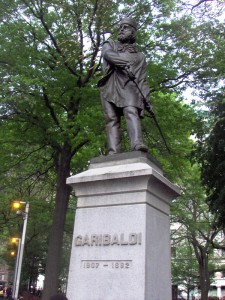 - Public stauary in New York City is much like trees. Within the many parks, there are lots of trees as well as statues; outside of the parks, the trees are less obvious as are the statues. However, there are still many.
- Public stauary in New York City is much like trees. Within the many parks, there are lots of trees as well as statues; outside of the parks, the trees are less obvious as are the statues. However, there are still many.
Outside the park the sculpture is a bit more modern and often abstract. Let’s move from one to the other.
This statue of Garibaldi is typical of the many statues from the early 20th Century that depict somewhat realistic images of heroic and public types. There’s usually an attempt to make the people a bit larger than life. Some of these are more daring and/or dynamic than others.
Garibaldi sits in NYU’s Washington Square Park, downtown, and has an important place within that park.
_____(Click any image to enlarge.)
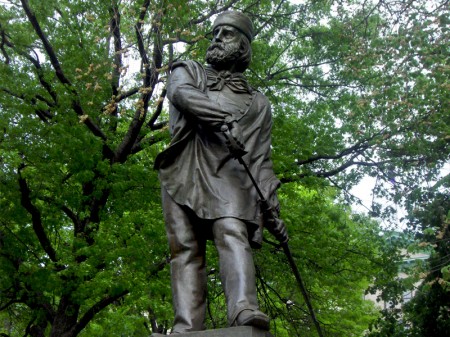
Giovanni Turini’s statue was made for an Italian American organization
and donated to the park in 1888. It has developed a handsome patina which
allows it to nestle in among the beautiful summer greens around it.
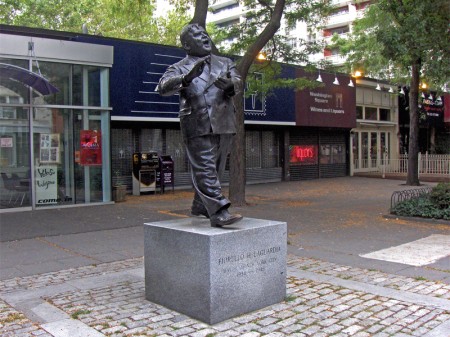
Just outside of Washingon Square Park there’s a mall of a street
filled with small shops and restaurants, LaGuardia Place. Among and
in front of theses shopos is a statue of Fiorella LaGuardia, the mayor of
New York from 1934 to 1945. The statue is by sculptor Neil Estern.
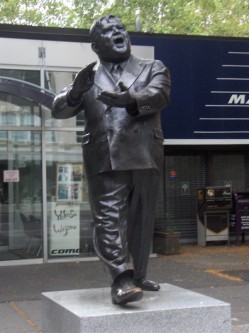

All I really know about LaGuardia was that he read the Hearst comic strips,
“Puck, the comic weekly,” on Sundays over the radio. An odd little fact that
Chuck McCann told us in his weekly Sunday kiddee show in NY during the 60′s.
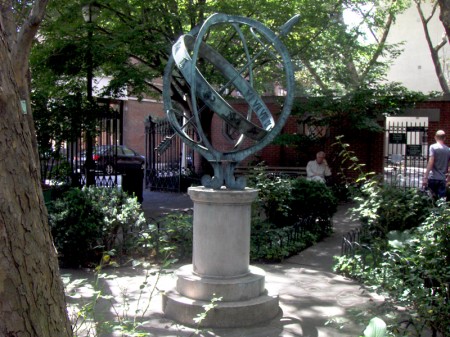
In a very small park off Sixth Ave. and Bleecker St., called
Winston Churchill Square, there’s there’s this armillary on a pedestal
centered in among park benches and greenery.
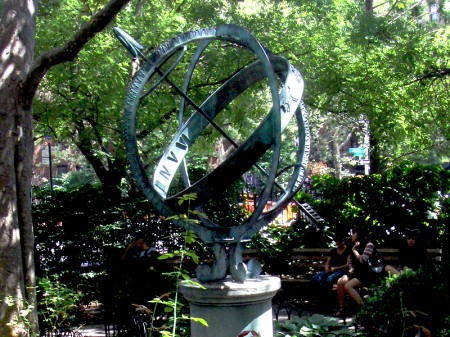
The park was designed by George Vellonakis.
He may have designed the sculpture.
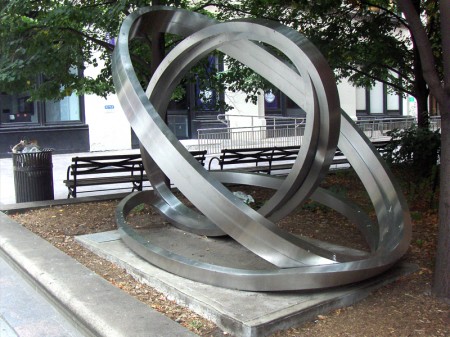
What looks like a more abstract version of an armillary sphere sits among
the buildings of NYU. Here are two views from both front and back.
These sculptures are all within six city blocks of my studio.
There are thousands more in New York, and I’ll post more soon.
Commentary 05 Aug 2008 08:10 am
Tarzan
- On Sunday night, Telemundo ran Tarzan, and I watched about half of it. (I have the dvd but never think to pull it out.)
I remember taking my studio to the first screening of this in New York. A past editor of mine, Greg Perler, had edited it, and I was particularly interested in seeing his film and supporting the work. A number of things bothered me, and I suppose I didn’t give the movie as high a review as I would today. The event was colored by seeing Sting at the ticket booth as we were exiting. He turned and I nodded to him; he nodded back though he didn’t know me from adam. I remember well his beautiful camel hair coat. A brief memory.
Anyway, looking at the film again, many years later, I see that there’s some really fine animation in the beginning of the film, and I was almost in awe of the excellent assisting and cleanup on the film. The line work was quite fine. I very much like the animation of the cheetah/villain. It must have been pretty hard to do the character walking on the net as seen from a 3/4 overhead shot. Hard work to pull off.
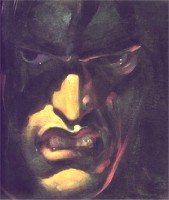 The film has an interesting style. It uses quite daring closeups throughout, almost as if it were trying to get into the heads of the cartoon characters. This is quite effective at times. I suppose it was during one of these early closeups that I got in tune with the amazing linework around the apes’ noses.
The film has an interesting style. It uses quite daring closeups throughout, almost as if it were trying to get into the heads of the cartoon characters. This is quite effective at times. I suppose it was during one of these early closeups that I got in tune with the amazing linework around the apes’ noses.
Walt Disney once said that if a closeup were on the screen too long it would become obvious to the audience that it were no longer looking at Donald Duck but at a drawing. I always questioned that thought and wondered how long was too long on a good closup. This film seemed to try to challenge that idea and really, for the most part, pulled it off.
The length of the closeups also played nicely against the rollerblading through trees which, to me, moved too quickly. (I also thought it challenged the laws of probability. If the character were real, the skin of his soles would have been ripped off his feet immediately. It was just Glen Keane’s attempt to inject a popular fad into the film. But then we also have an elephant using his trunk like a periscope. He looks to see above water with his nose; a 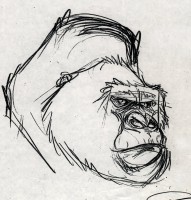 handy trick elephant’s can perform, I guess.)
handy trick elephant’s can perform, I guess.)
The computerized backgrounds really was a break through. I found it hard, at times, to tell the difference between the painted BGs and the computer rendered ones and thought that some of the computer rendering quite graceful.
The film in Spanish was better off without Rosie O’Donnell’s voice but suffered a great loss without Minnie Driver’s. Her voice work has to be one of the great female voiceover performances post Beauty and the Beast feature length film.
- While watching this film – even in Spanish – it was obvious to me how much better the performances of the characters were in comparison to anything I’ve seen recently. I know there are a lot of fans out there supposting the new technology, but I still don’t see how the animation part will get any better. The technology will improve, and the realistic representation of the characters will improve, but I’m not sure animators will be able to find 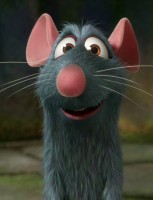 the soul of any of these characters and then be able to translate that through the medium to us.
the soul of any of these characters and then be able to translate that through the medium to us.
The closeups in Tarzan were so well done that I was forced to think of Mark Mayerson‘s writing about animated acting. I have often compared animated characters to the performance you would get from a live actor. The slight change of the eyes, the actual thought process that is revealed through the camera. The slightest motions. Perhaps they were onto something with Tarzan. Of course, this family friendly film meant it had to have superfast gliding and swinging and fighting. However, it’s in the slow scenes that the film gets any magic that it has, and the animators have well earned it.
___But does it breathe?
Don’t miss Hans Perk‘s series this week on the multiplane camera.
Animation Artifacts &Commentary &Hubley 01 Aug 2008 08:05 am
Everybody Rides – 2
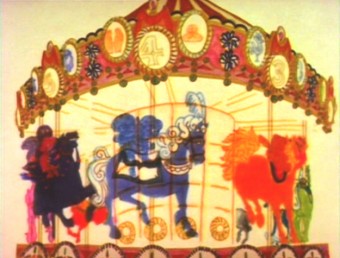 – We started slowly on Everybody Rides the Carousel. There was a six month schedule for about 72 mins of animation. Three half-hour original tv shows for CBS about 24 mins each. They’d air in the late summer of 1975 just prior to the start of the new tv season. Each show would air a day apart from the others – three nights in a row.
– We started slowly on Everybody Rides the Carousel. There was a six month schedule for about 72 mins of animation. Three half-hour original tv shows for CBS about 24 mins each. They’d air in the late summer of 1975 just prior to the start of the new tv season. Each show would air a day apart from the others – three nights in a row.
John and Faith spent a lot of time – a lot of time – at RCA studios on 45th Street. (It’s
____ The carousel was bottom lit & became soft focus.____-_ now an IRS office.) They recorded many of voices playing the numerous parts in their show. I tried to time meeting them there a couple of times hoping to meet some of the actors (I particularly wanted to see Jack Gilford in action. He was doing an hilarious part with his wife, playing a couple of cranky old people in a diner.) It didn’t work out that way, but I did see the facility and heard parts in process.
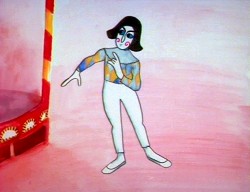 The key staff working IN the studio (not counting animators who would, for the most part, work freelance) included Ida Greenberg. Ida was a brilliant checker/coordinator who’d started back in the Florida days of the Fleischer studio. (She told me a few great stories about Gulliver’s Travels.) Ida was a great woman, with the thickest New Yowk accent, who never seemed to buckle under pressure. I grew very close to her. I tried after that to have Ida everywhere I worked. She led Raggedy Ann’s I&Pt and R.O.Blechman’s special._____________ Art Babbitt animated some of the mimes.
The key staff working IN the studio (not counting animators who would, for the most part, work freelance) included Ida Greenberg. Ida was a brilliant checker/coordinator who’d started back in the Florida days of the Fleischer studio. (She told me a few great stories about Gulliver’s Travels.) Ida was a great woman, with the thickest New Yowk accent, who never seemed to buckle under pressure. I grew very close to her. I tried after that to have Ida everywhere I worked. She led Raggedy Ann’s I&Pt and R.O.Blechman’s special._____________ Art Babbitt animated some of the mimes.
Kate Wodell was a student of the Hubleys at Yale. She was a talented artist who’d moved into production during the making of Cockaboody and continued on staff there. Sometimes she colored, sometimes she animated, sometimes she did whatever was necessary. This was exactly how I moved into the studio and loved the experience. She worked with Faith for many years after John died.
Earl James was an animator who’d worked in the backroom of many NY studios from Paramount to Terrytoons to NY Institute of Technology. He also had done some comic strip work.
Earl was given the carousel to animate. This came from a couple of elaborate drawings John did. Earl worked 16 fld. using a 96 drawing cycle. It gave us a lot of opportunity to move in tight or stay wide. However, it was a nightmare that took forever. Joe Gray was hired to assist Earl. (Joe started during the Terrytoons strike and never left. He was a lifetime assistant like a handful of other noted names in NY.)
This scene moved so slowly through production that I kept jumping in to assist as well. I was a fast assistant, but that carousel slowed even me down. 8 horses moved in perspective in a circle; you got to see 96 different rotating views of all the horses. I’d guess the scene took about 10 weeks to complete.
I was also doing layout and animation of a lot of connecting scenes throughout the production. These were scenes that would have to blend from one animator to another, or John had decided to go in tight for a closeup. In one case with Art Babbitt’s mime character, I was asked to change it from two’s to four’s with a dissolve technique John taught me (he said they’d used it on Fantasia.)
There were four people in my room, Earl, Joe, me and Mark Hubley. He worked alongside me for most of the film. He colored artwork given him by Ida, who was working in the larger room next door. Mark and I had a good releationship going back the many years I worked there. He joined the studio once he completed college. Emily Hubley worked alongside Kate and Ida.
Two younger, more experimental animators were brought in by John. Adam Beckett had made a name for himself with the films he was doing at CalArts.
Fred Burns was doing some incredible work at UCLA. They both were very different and added their unique touch.
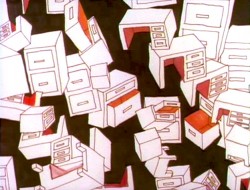
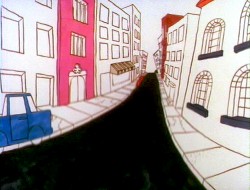
___________ Adam Beckett’s scenes included these two surreal images.
Adam did a scene a couple of scenes wherein office furniture floated about in a very complicated surreal cycle. Fred did this amazing scene of a roller coaster from the POV of the rider. He and I worked together a number of times after that, and we’ve stayed friends.
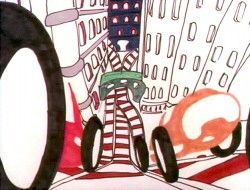
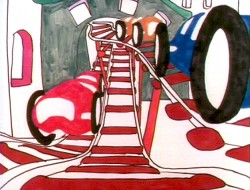
______________ Fred did this very elaborate sexual roller coaster.
I decided, last week, that I had a lot to say about this feature film. Hence, you’ll have to excuse me for reminiscing over the series of pieces I’m going to write. I also have some artwork – other than frame grabs – that I’ll try to share in future pieces.

